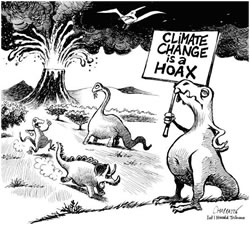This past election should be a reminder to all of us that while some people consider basic assumptions as “givens,” others vehemently disagree.
That’s been the case about climate change. While 2012 has now been designated as the warmest year in the history of the U.S., marked by a number of extreme weather events, climate change deniers demand to be heard. 
That same mentality is very much alive in radio. Even though there is evidence – and lots of it – that consumers are adopting digital lifestyles, there are still many in radio who proudly claim to be “digital deniers.”
Some believe that all this digital stuff is being driven by a bunch of bloggers and pundits who have some sort of agenda about pushing new technology – at the expense of the transmitter and tower model.
And just last week at Arbitron’s Client Conference, I bumped into more than a couple people who got into my grille about “Why the rush to digital?” when the lion’s share of radio listening is taking place on traditional radios.
One even suggested that not only was my thinking way too far in front, but that digital consumption of audio might never reach a point of critical mass that would make it viable or profitable.
How much more evidence do they need?
Scarborough recently released new data that shows that heavy radio listeners are more apt to use the Internet and mobile devices for entertainment. As they point out, “That means a station’s most active users are ready, willing and able to engage with it online and on smartphones.”
Of course, younger consumers of radio are even more apt to be wired this way. Two-thirds of Millennials fall into this group, while half of Gen X-ers concur. The laggards, of course, are Baby Boomers, but even a third of them agree about the Internet and entertainment.
But the reverse is true for heavy listeners of radio, twice as likely to come from the Boomer generation than from Millennials.
And therein lies the challenge, and the importance of seeing the landscape and reacting accordingly. Clear Channel’s Brian Lakamp speaking about iHeartRadio at the conference revealed that half the consumption of their audio occurs on mobile devices.
 As the automakers and engineers who were captured on our videos pointed out, it is critically important to provide content to consumers wherever and whenever they like.
As the automakers and engineers who were captured on our videos pointed out, it is critically important to provide content to consumers wherever and whenever they like.
For eight years now, our Techsurveys have tracked this behavior, focusing in on radio’s core audience, largely coming from station databases. Like Scarborough, we see the same phenomena occurring. Core radio listeners are very engaged with other digital media and gadgets.
But the key to understanding the digital “climate change” is to get away from the spreadsheets and analytics. Spend time with real people – of many different ages and backgrounds. Listen to them talk about their new-found choices and gadgets. Every year, I conduct scores of focus groups, listener advisory board sessions, and dial tests.
Time spent listening – to consumers – is at the heart of understanding the directionality of infotainment consumption and changing habits. The numbers tell you what has happened. Taking that deeper dive into perceptions and attitudes will provide you with clues about radio’s future.
It comes down to this: radio’s challenge – and its opportunity – is to make its content available on these devices because fickle consumers will go elsewhere to get what they want.
The radio industry may have great, storied brands, but as one of media’s smartest guys, Abbey Konowitch, noted at the Arbitron conference, “Brands sit in boats today – they’re not on solid ground.”
That’s because change is in the air. It’s a constant. Consumers are moving quickly, buying new devices, and discovering new ways to entertain and inform themselves.
Brands that continue to be content-rich, connected with their local communities, and personality-focused are positioned to not just survive in this environment, but to thrive.
But it requires that broadcasters understand their audiences, where they’re going, and a willingness to take that journey with them.
It requires that broadcasters get over the fact that measurement is still rudimentary, and hasn’t kept up with actual consumer usage.
It requires that broadcasters understand that monetization isn’t going to happen overnight, and they may have to build infrastructure, connection points, and an understanding with listeners and advertisers before cash starts flowing in the door.
Simple, right?
Then why are some broadcasters struggling with this reality?
Are they being financially prudent to hold back?
Or are are they in denial?
- A 2020 Lesson?It Could All Be Gone In A Flash - April 24, 2025
- How AI Can Give Radio Personalities More…PERSONALITY - April 23, 2025
- Can Radio Afford To Miss The Short Videos Boat? - April 22, 2025




The answer is both. There is no money to be made in digital delivery of audio and all one needs to do to confirm that is look at Pandora’s SEC filings and conference call statements. No money today, no foreseeable path to it. So on one level they are being prudent.
That said, digital delivery is the future. Although Arbitron data swears otherwise, ask any college kid if they have a radio other than the one in their car (if they have one) and the answer is almost always no. So radio is faced with a choice – stick with and encourage what makes money, or embrace the future and go broke. What a choice!
I agree that many, perhaps most at the top in radio are in denial – some of that could be age related and much of it probably revolves around fiduciary responsibility. They are out of touch IMO, but not because they are reluctant to burn money in the cloud, but because they don’t realize how important reasonable royalties are to radio’s future.
This issue won’t go away because a couple of small deals with a label or two is made – with PR firms probably the biggest beneficiaries. This will be an ugly fight with an industry that has always gotten its way – and seems to be winning the fight in congress. And no, what has been done up til now has not been up to the task, unless there is some real hardball being played behind the scenes.
But first, the folks at the top need to immerse themselves in how their kids and grandkids live. Then figure out how to give em what they want and make money at it. And that needs to happen now, before radio faces the big digital “Whoops” that the print industry is currently facing.
Research and analytics are wonderful in a stable environment. They can track progress and incremental change. But that’s not what’s going on in America’s culture and lifestyles today. Watching a cluster of commercials during a football game this month reveals everything you need to know about what people are doing digitally and how their media lives are being radically altered by technology. How many more smartphones and tablets will be in consumers’ cars, bedrooms, and offices in January? Thanks for your comments, Bob.